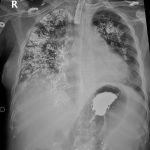Cancer can sometimes spread into the lymph nodes in the groin. Your groin is the area at the top of your legs, between the hips. This can happen with different types of cancer, such as anal and penile cancer.
To check the lymph nodes in your groin for cancer cells, your doctor checks the groin for swollen (enlarged) lymph nodes. You then might have an ultrasound scan to check the nodes. Ultrasound scans use high frequency sound waves to create a picture of a part of the body.
If doctors find any abnormal lymph nodes, they use the ultrasound to guide a needle and take a sample of tissue. This is also called a fine needle aspiration (FNA).
What is a lymph node?
A lymph node is part of the lymphatic system. This is a network of thin tubes (vessels) and nodes that carry a clear fluid called lymph around the body. This is an important part of the immune system. It plays a role in fighting infection and destroying old or abnormal cells.
The nodes are bean shaped structures that filter the lymph fluid and trap bacteria and viruses, and cancer cells.
Preparing
You’ll be given written instructions on how to prepare for your lymph node ultrasound and biopsy. You should be able to eat and drink normally beforehand.
Take your usual medicines as normal unless your doctor tells you otherwise. If you take warfarin or other medicines to thin your blood, you need to stop this before your test. Your doctor will tell you when to stop them.
Your doctor or nurse give you information about the procedure and might ask you to sign a consent form. This is a good time to ask any questions that you have.
What happens during the lymph node ultrasound scan
You usually have this test in the x-ray department. You usually put on a hospital gown and lie down on the scanner couch.
A specialist doctor called a radiologist does the scan. They put a gel over your groin area and hold an ultrasound probe on your skin. They move the probe over the skin.
You might feel a little pressure when they move the probe. It shouldn’t hurt. Tell them if it is uncomfortable for you.
If your doctor sees any changes in the lymph nodes on the ultrasound, they might take a biopsy.
What happens during the lymph node biopsy
Your doctor cleans your skin and numbs the area with local anaesthetic  . This might sting a little.
. This might sting a little.
When the area is numb, they put a fine needle through your skin. Then they take a sample of cells. They might use the ultrasound to help guide the needle into the lymph node.
You will feel some pressure on the groin, and it can sometimes feel uncomfortable. Let the doctor know if it’s painful.
Your doctor removes the needle once the sample is taken. They put pressure on the groin for a few minutes after the test. This is to prevent bleeding and bruising.
After the lymph node ultrasound and biopsy
You should be able to go home soon afterwards.
You will have a small dressing over the biopsy area. Your doctor or nurse will tell you how to look after this for the next few days.
Your doctor sends the sample of cells to the laboratory where a specialist doctor called a pathologist looks at it under a microscope.
Possible risks
A lymph node ultrasound and biopsy is a very safe procedure, but your nurse will tell you who to contact if you have any problems after your test. Your doctors will make sure the benefits of having this test outweigh these possible risks.
Pain
You may have some discomfort once the local anaesthetic has worn off. This usually settles within 1 to 2 days.
Bleeding
You might see a small amount of blood on the dressing after the biopsy. Let your doctor or nurse know straight away if there is a lot of bleeding from your biopsy site.
Swelling
Some people have swelling afterwards, but this is rare. Let your doctor know if the area is swollen or very painful.
Infection
Contact your GP or the hospital if you have a high temperature, feel unwell or if there is swelling at the biopsy site.
Getting your results
You should get your results within 1 or 2 weeks at a follow up appointment.
Waiting for test results can be a very worrying time. You might have contact details for a specialist nurse who you can contact for information if you need to. It can help to talk to a close friend or relative about how you feel.



